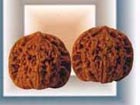| Videos | • Latest |
|
• Feature | • Sports | • Your Videos |
A new take on walnut art

 0 Comment(s)
0 Comment(s) Print
Print E-mail
CNTV, January 29, 2012
E-mail
CNTV, January 29, 2012
Not everyone can see treasure in the trivial. And it takes even more of an eye to develop the trivial into art. Today we meet a Beijing artist who transforms humble walnuts into magical and artistic creations.
Every morning, Lu Xiaorong and his friends gather in the park around Beijing's Temple of Heaven. They don't come to jog or practice taiqi like the other early-risers, their form of exercise is less obvious to the unknowing eye - in the palm of their hands, they hold a pair of walnuts moving the walnuts round and round massages the hand and also polishes the shell.
The culture surrounding walnuts has a long history in China. Using walnuts to gently exercise the hands dates back to the Han Dynasty, around two thousand years ago. The practice, known as "walnut therapy" reached its heyday towards the latter end of the Ming Dynasty, five hundred years ago.
Wild walnuts are better for walnut therapy because they're harder than the cultivated, edible types. If a pair is used for a long time, their shells will become darker and more transparent. The ancient belief is that this is because the flesh and blood of the user has been rubbed into the shell. As such, rubbed walnuts have different characteristics depending on the individual who used them.
Well-used wild walnuts have become collector's items in Beijing. Their values differ dramatically depending on their shape, color, and age.
Nicknamed "Walnut Lu", Lu Xiaorong is famous across Beijing as a "walnut therapist". But he's more than just that. Over the past four years, he's also been making a name for himself as a "walnut artist".
Lu Xiaorong said, "I was rubbing some walnuts that weren't completely dry yet, which meant they cracked easily. I couldn't use them any more after they'd cracked, but I couldn't bear to throw them away either. Then, I got to thinking that since the outside of the walnut looks so amazing, maybe the inside is the same. So I opened up some of my cracked walnuts... they weren't any use to me any more anyway. Opening them up, I found that the insides were just as lovely as the outsides."
Each autumn, Lu Xiaorong goes on a nationwide search for walnuts. He often brings home a whole truckload. There, Lu puts the walnuts through a complex process. They are carefully sawn open, the kernels are removed, and the shells are soaked in water. The pieces are then put together and polished. The result is art - each piece featuring sophisticated and delicate patterns.
Each year during the Chinese Spring Festival, Walnut Lu takes his art to one of Beijing's bustling temple fairs. The intriguing items on sale at his stall always prove popular with visitors.
Chinese folklore has it that walnuts can ward off evil. Lu's artwork draws inspiration from the auspicious meanings attached to the nut. His designs symbolize longevity, safety, reunion, faithful love, health, and wealth.
Lu Xiaorong said, "From this direction, it looks like a plum blossom. And from this side, this is a head and it looks like a tortoise. It stands for longevity."
Lu first started walnuts therapy in 1996, when he was diagnosed with diabetes. Traditional Chinese medicine believes that accelerating the circulation of the blood can help treat the condition. Worrying walnuts is one way to get your circulation going. Lu took up the exercise when one of his friends told him it could cure the numbness in his fingers.
It changed his life. Not only did the therapy help cure his diabetes, the walnuts also gave him the inspiration to develop a completely new form of folk art.
Even though it can be tiring, Lu loves his craft. The magic of Mother Nature keeps him going.
Lu Xiaorong said, "Walnuts are just like people. Every walnut is different. The patterns on the insides of their shells are always unique. Cutting them from different angles accentuates even more their individuality. I am constantly in awe at the power of nature. No craftsman can create anything as beautiful as these natural patterns. "
Not only reaping joy from his work, Walnut Lu has also received praise for his creations. During the closing ceremony of the France Culture Year in China at the end of 2005, Lu's walnut masterpieces were chosen as quintessential examples of Chinese folk art.
He is currently compiling a book about walnut art and the nut's history in China. He says his art shouldn't be something that belongs just to himself, but rather a culture that everyone can share in.






Go to Forum >>0 Comment(s)